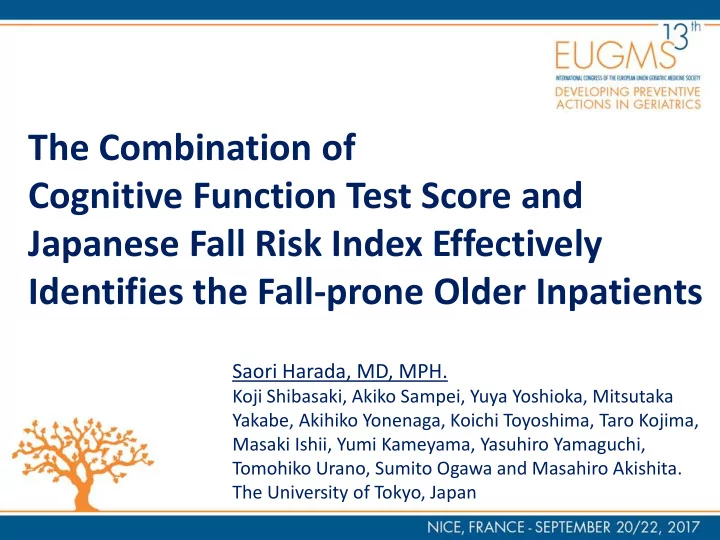

The Combination of Cognitive Function Test Score and Japanese Fall Risk Index Effectively Identifies the Fall-prone Older Inpatients Saori Harada, MD, MPH. Koji Shibasaki, Akiko Sampei, Yuya Yoshioka, Mitsutaka Yakabe, Akihiko Yonenaga, Koichi Toyoshima, Taro Kojima, Masaki Ishii, Yumi Kameyama, Yasuhiro Yamaguchi, Tomohiko Urano, Sumito Ogawa and Masahiro Akishita. The University of Tokyo, Japan
CONFLICT OF INTEREST DISCLOSURE I have no potential conflict of interest to report.
Background – Falls in older age ・ Falls are the second leading cause of accidental or unintentional injury deaths worldwide. ・ Adults older than 65 years of age suffer the greatest number of fatal falls. e.g. Hip fracture , traumatic brain injury, spinal cord injury ・ Falls may also result in a post-fall syndrome that includes dependence , loss of autonomy , confusion , immobilization and depression , leading to a further restriction in daily activities. WHO Global Report on Falls Prevention in Older Age
Japanese Fall Risk Index 1) History of falls in the past 12 months 2) Stumble sometimes 3) Cannot go up or down the stairs without handrails 4) Decreased walking speed 5) Cannot cross a road while the traffic light is green 6) Cannot walk 1km without a break 7) Cannot stand on one foot for 5 sec (eyes open) Japanese Fall Prevention Guideline, Kenji Toba et al. 2012 8) Cane user 9) Cannot squeeze a towel tightly 10) Dizziness or Staggering 11) Bent back 12) Pain in knees 13) Visual disturbance 14) Hearing problem 15) Forgetfulness 16) Fear of falling Simple screening test for risk of falls in the 17) 5 or more medicines every day elderly. Okochi J, Toba K, Takahashi T et al. 18) Feel the house is dim while walking at home Geriatr Gerontol Int 2006;6:223 – 227. 19) Obstacles inside the house when walking “Fall Risk Index” helps clinicians identify 20) Level differences on the house floor high-risk individuals JMAJ 52(4): 237-242, 2009 . 21) Have to use stairs daily 22) Have to walk on steep slope around home
Cognitive function test ・ Poor cognitive function is known to be related with higher fall risk. ・ Carey E. Gleason et al found the prospective rate of any falls over 12 months increased by 20% for each point decrease in Mini Mental State Exam (MMSE) among 172 community-dwelling older adults.
Study Aim To identify the more high-risk fall-prone population among the geriatric inpatients, by the combination of Cognitive function test and Japanese Fall Risk Index.
Patients and Methods ・ We utilized the geriatric ward database of 253 inpatients in the University of Tokyo Hospital, discharged from April 2016 to March 2017. ・ Patients were mainly admitted for cognitive impairment or treatment against illnesses such as pneumonia, diabetes mellitus and heart failure. ・ Database records patients’ characteristics, a history of falls in the past 1 year, Fall Risk Index and MMSE. ・ Logistic regressions and Receiver Operating Characteristic (ROC) curves were evaluated using SPSS software. Outcome was the fall history in the past 12 months.
Baseline characteristics Characteristics Geriatric Ward Database (N=253) Age, years 82.7±6.7 (min 52, max97) Sex, N (%) Men 111 (43.9%) Women 142 (56.1%) Skeletal Muscle Mass Index (SMI), kg/m 2 6.7 ± 1.8 Body Mass Index, kg/m 2 22.1 ± 4.5 0.94 ± 0.35 Walking speed, m/s 4.0 ± 1.9 (min0, max8) Specific Activity Scale, METs 6.3 ± 3.9 (min0, max15) Geriatric Depression Scale (/15) 8.6 ± 2.0 (min0, max10) Vital Index (/10) Living alone, N(%) 135 (53.4%) Comorbidities, N (%) Hypertension 137 (54.6%) Diabetes mellitus 67 (26.5%) Dyslipidemia 114 (45.1%) Cerebrovascular diseases 202 (81.1%) Cardiovascular diseases 227 (91.2%) Sarcopenia 72 (61.5%) 11 ± 4 (min0, max20) Fall Risk Index (/21) MMSE (/30) 23 and more, N (%) 103 (53.9%) less than 23, N (%) 88 (46.1%) Fall in the past year, N (%) 77 (46.7%) 20.2 ± 16.0 (min1, max 115) Hospitalization, days
Results Logistic regression: Variables OR [95% CI] p Age 1.054 [0.972-1.143] 0.205 Sex 2.398 [0.910-6.323] 0.077 SMI 1.055 [0.956-1.164] 1.055 Fall Risk Index (/21) 1.156 [1.018-1.312] 0.025 MMSE (/30) 2.788 [1.067-7.194] 0.036 Sex: The reference group is women. MMSE: Dichotomized at the cutoff points of 23/30. The reference group is patients with 24 or more MMSE scores.
Results Fall Risk Index (continuous) Fall Risk Index (continuous) for the whole population for the population with 23 or less MMSE AUC: 0.664 [0.571, 0.758] p=0.001 AUC: 0.723 [0.577, 0.869] p=0.011
Conclusions In our patient group, ・ Both the higher Fall Risk Index and the cognitive impairment with lower MMSE score showed significantly higher fall odds ratios. ・ When we applied the Fall Risk Index evaluation to the cognitively impaired population with lower MMSE score , the area under the ROC curve got larger, meaning the test got higher accuracy. >>We suggest for the inpatients, using both the Fall Risk Index (FRI) and MMSE can identify more high-risk fall-prone patients.
Strength and Limitations ・ Detailed records of comprehensive geriatric assessment. ・ Missing numbers in each variable. ・ The weight of each risk factor may vary among different populations. ・ Our study’s target is sicker patients with many comorbidities.
Acknowledgement Department of Geriatric Medicine, The University of Tokyo Hospital Professor Masahiro Akishita Dr. Koji Shibasaki Travel grant from The Japan Foundation for Aging and Health
Recommend
More recommend